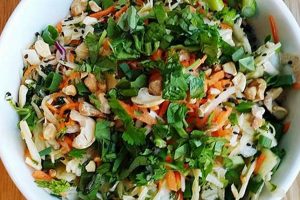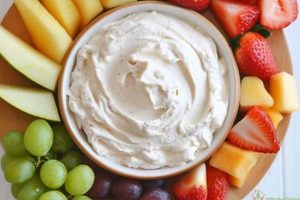A compilation of culinary instructions focused on plant-based adaptations of dishes originating from Thailand forms the core of such a resource. It provides detailed guidance for recreating familiar Thai flavors without relying on animal products. For instance, it might offer variations on Pad See Ew using tofu or tempeh instead of traditional meats, or substitute plant-based milk for dairy in green curry recipes.
The value of these resources lies in providing accessible pathways to enjoy the diverse flavors of Thailand while adhering to ethical or dietary restrictions. Historically, Thai cuisine has incorporated various animal-based ingredients, but increased awareness of dietary choices and environmental concerns has driven the demand for plant-based alternatives. These books address this need by offering both classic and innovative recipes that cater to this growing demographic.
Therefore, further discussion will explore the specific types of recipes commonly found within these culinary guides, the challenges involved in adapting traditional Thai flavors, and the critical role these books play in promoting both healthy eating and cultural exchange.
Culinary Guidance
This section offers practical advice extracted from publications focused on preparing plant-based Thai meals. The tips provided aim to enhance both flavor and authenticity while adhering to vegan principles.
Tip 1: Master the Foundation. Essential Thai flavors derive from a balance of sweet, sour, salty, and spicy elements. Understand how ingredients like lime juice, tamarind paste, soy sauce, and chili peppers interact to create the characteristic taste profiles. Experiment with these components in small quantities to fine-tune dishes to individual preferences.
Tip 2: Embrace Tofu Transformation. Tofu serves as a versatile protein source. Pressing firm or extra-firm tofu removes excess water, improving texture and its ability to absorb marinades. For a chewier consistency, consider freezing and thawing tofu before pressing.
Tip 3: Leverage Coconut Milk Wisely. Coconut milks fat content varies. Full-fat coconut milk imparts richness and creaminess to curries, while light coconut milk offers a lower-calorie alternative. Refrigerating a can of full-fat coconut milk separates the cream from the water, allowing for selective use in enriching sauces or creating decadent desserts.
Tip 4: Explore Plant-Based Fish Sauce Alternatives. Traditional fish sauce imparts a distinct umami flavor. Vegan substitutes often utilize seaweed, shiitake mushrooms, or soy sauce to replicate this savory depth. Experiment with different brands and combinations to find a profile that suits specific recipes.
Tip 5: Prioritize Fresh Herbs and Spices. Fresh herbs like cilantro, Thai basil, and mint contribute vibrant aromas and flavors. Incorporate them generously towards the end of cooking to preserve their potency. Similarly, freshly ground spices offer a more intense and nuanced flavor than pre-ground varieties.
Tip 6: Navigate Curry Paste Composition. Pre-made curry pastes offer convenience but often contain non-vegan ingredients. Examine labels carefully or consider making homemade curry paste to control the ingredients and ensure a plant-based composition. Utilize a mortar and pestle for optimal flavor extraction.
Tip 7: Incorporate Sticky Rice Expertise. Properly cooked sticky rice provides an authentic accompaniment to many Thai dishes. Soak the rice for several hours before steaming to achieve the desired texture. Use a traditional bamboo steamer for optimal results.
These suggestions, derived from expert culinary sources, aim to empower individuals in their pursuit of crafting delicious and authentic plant-based Thai meals. Understanding these fundamental principles allows for creativity and confidence in adapting recipes to individual dietary needs and preferences.
The following sections will delve further into specific recipe categories and address common challenges encountered in plant-based Thai cooking.
1. Authenticity Adaptation
The phrase “authenticity adaptation,” when applied to plant-based Thai recipe collections, denotes the process of modifying traditional culinary preparations to align with vegan dietary principles while preserving recognizable Thai flavor profiles. The cause of this adaptation is the growing demand for plant-based options and the desire to experience Thai cuisine within specific dietary frameworks. This adaptation necessitates a careful consideration of ingredient substitutions and adjustments to cooking techniques to replicate the taste, texture, and appearance of conventional dishes. The importance lies in enabling individuals adhering to veganism to enjoy culturally relevant meals without compromising ethical or dietary commitments. A real-life example involves replacing fish sauce, a staple ingredient, with seaweed-based alternatives to maintain umami notes. The practical significance of understanding authenticity adaptation lies in achieving a satisfying culinary outcome that respects both the original dish and the plant-based restrictions.
Further, authenticity adaptation is not merely about simple ingredient swaps. It requires a nuanced understanding of the functional roles of each component in the original recipe. For instance, if a recipe traditionally calls for shrimp paste, a substitute must account for not only the flavor profile, but also the ingredients impact on texture and emulsification. This often involves combining multiple ingredients to achieve a comparable effect. Another example is the adaptation of Thai curries that historically incorporate dairy products. Utilizing coconut milk or other plant-based milk alternatives requires careful consideration of fat content and sweetness to maintain the dishs overall balance. Failure to adequately adapt such elements can result in a dish that lacks the depth and complexity characteristic of authentic Thai cuisine.
In summary, the connection between authenticity adaptation and plant-based Thai recipes underscores the importance of culinary creativity and a deep understanding of both traditional Thai flavors and vegan cooking techniques. Challenges arise in replicating specific textures and complex flavor profiles, requiring ongoing experimentation and refinement. Ultimately, successful adaptation fosters culinary inclusivity, allowing individuals with diverse dietary preferences to partake in the rich traditions of Thai cuisine.
2. Ingredient Substitution
Ingredient substitution is paramount when adapting traditional Thai recipes to align with vegan dietary practices. The effectiveness of the resulting dish is intrinsically linked to the successful replacement of animal-derived products with plant-based alternatives, maintaining the intended flavor profile and textural characteristics of the original recipe.
- Protein Replacements
The role of protein in Thai cuisine is often fulfilled by meats like chicken, pork, or seafood. In vegan adaptations, tofu, tempeh, and seitan serve as primary substitutes. Tofu’s mild flavor makes it adaptable, while tempeh offers a nuttier taste and firmer texture. Seitan, derived from wheat gluten, mimics the chewiness of meat. These substitutions require adjustments in cooking methods, such as marinating or pan-frying, to achieve desirable textures and flavor absorption.
- Umami Enhancement
Fish sauce, a cornerstone of Thai flavors, provides a distinctive umami taste. Vegan alternatives frequently employ seaweed, mushroom broth, or fermented soy products to replicate this savory depth. Shiitake mushrooms, known for their umami richness, can be transformed into a concentrated broth or used in powdered form. Black salt, with its sulfurous notes, can also contribute to the overall flavor profile. Careful calibration is necessary to avoid overpowering the dish.
- Dairy Alternatives
While not as prevalent as in some other cuisines, dairy products occasionally appear in Thai dishes. Coconut milk serves as a ubiquitous alternative, offering both richness and sweetness. Other plant-based milks, such as almond or cashew, may be used in specific instances, but their flavor profiles must be considered in relation to the other ingredients. Coconut cream can replicate the thicker consistency of dairy cream in certain preparations.
- Fat Source Adaptation
Traditional Thai recipes frequently utilize animal fats for flavor and texture. In vegan adaptations, plant-based oils, such as coconut oil, peanut oil, or sesame oil, fulfill this role. The choice of oil influences the final flavor profile, necessitating careful consideration. Furthermore, the use of nut butters or avocado can contribute to creaminess and richness in sauces and dressings.
These substitutions exemplify the challenges and opportunities inherent in creating plant-based versions of classic Thai recipes. Success hinges on a thorough understanding of the original ingredients’ functions and a skillful application of plant-based alternatives to replicate their contributions to the dish’s overall taste, texture, and aroma. The ongoing refinement of these substitution techniques continues to expand the possibilities for creating authentic and satisfying vegan Thai meals.
3. Flavor Balancing
Flavor balancing represents a critical element in the successful adaptation of Thai cuisine within the constraints of a plant-based framework. The harmonious interplay of sweet, sour, salty, spicy, and umami tastes characterizes authentic Thai dishes. Achieving this balance in vegan recipes requires a nuanced understanding of ingredient interactions and skillful manipulation of flavor profiles.
- Sweetness Calibration
Palm sugar traditionally imparts sweetness in many Thai preparations. Vegan recipes can utilize alternatives like maple syrup, agave nectar, or coconut sugar. Each possesses a distinct flavor profile, necessitating careful calibration to avoid overpowering other elements. The subtle caramel notes of palm sugar may require a combination of substitutes to fully replicate.
- Acidity Adjustment
Lime juice and tamarind paste provide essential sour notes. Adjusting the ratio of these ingredients is crucial in vegan dishes, where the absence of animal fats can alter the perception of acidity. For example, a dish lacking the richness of fish sauce might require a slightly higher proportion of lime juice to achieve the desired tartness.
- Saltiness Source
Fish sauce contributes a significant salty and umami component. Vegan substitutions, such as soy sauce or tamari, provide the saltiness but lack the same depth of flavor. Therefore, careful consideration of the salt concentration and potential addition of other umami-rich ingredients is essential to compensate.
- Spiciness Control
Chili peppers are integral to Thai cuisine. Different varieties offer varying levels of heat and distinct flavor profiles. Controlling the spiciness in vegan dishes is crucial, as the absence of dairy or fatty meats can amplify the perception of heat. Careful selection of chili type and precise measurement are essential for achieving a balanced level of spiciness.
Successfully navigating flavor balancing is central to producing compelling plant-based adaptations of Thai recipes. The interplay of sweetness, acidity, saltiness, and spiciness demands meticulous attention to detail and a thorough understanding of ingredient interactions. The resulting culinary creations can capture the essence of Thai cuisine while adhering to vegan principles, offering a satisfying and authentic dining experience.
4. Recipe Variety
The inclusion of diverse recipes represents a pivotal attribute of any credible plant-based Thai recipe collection. Its presence directly influences the resource’s utility and appeal to a broad spectrum of users. The cause of this connection is the inherently diverse nature of Thai cuisine itself, encompassing numerous regional variations and culinary traditions. This necessitates a comprehensive range of offerings within any book aiming to represent the cuisine adequately. The importance of this diversity lies in catering to varying skill levels, dietary needs, and taste preferences. A limited selection restricts user engagement and diminishes the overall value of the publication. For instance, a compilation that only features curry dishes fails to address other essential elements of Thai cuisine, such as soups, salads, stir-fries, and desserts. The practical significance of recipe variety lies in providing users with the tools to create a complete and satisfying vegan Thai culinary experience.
Further analysis reveals that recipe variety extends beyond merely listing different dishes. It involves offering multiple variations of popular recipes, allowing for ingredient substitutions based on availability or personal preference. For example, a book might include several Pad Thai recipes, each adapted for different skill levels or utilizing alternative noodle types. This adaptability enhances the resource’s accessibility and encourages experimentation. Another critical aspect is the inclusion of recipes that cater to specific dietary restrictions beyond veganism, such as gluten-free or soy-free options. Addressing these diverse requirements broadens the books appeal and strengthens its relevance to a wider audience. The practical application of this principle involves providing clear and concise instructions for substitutions, along with potential adjustments to cooking times or techniques.
In summary, the connection between recipe variety and plant-based Thai cookbooks highlights the importance of comprehensiveness and adaptability. Challenges arise in balancing the desire for authenticity with the need for accessibility and dietary inclusivity. However, a thoughtfully curated selection of recipes strengthens the resource’s value, promoting both culinary exploration and adherence to plant-based dietary principles. This approach is critical for fostering a deeper appreciation of Thai cuisine while accommodating diverse culinary needs.
5. Dietary Needs
The consideration of dietary needs is a crucial component in the creation and utilization of any plant-based Thai recipe compilation. The primary cause for this emphasis stems from the increasing prevalence of dietary restrictions and lifestyle choices, including but not limited to veganism, allergies, and intolerances. The importance of addressing these needs within a vegan Thai recipe resource lies in ensuring accessibility and inclusivity for a wider audience. A compilation that disregards common allergens, such as gluten or soy, limits its usability for individuals with specific dietary restrictions. A real-life example involves a vegan Pad Thai recipe that omits peanuts or includes clear alternatives, catering to individuals with peanut allergies. The practical significance of understanding this connection centers on creating a resource that is not only plant-based but also adaptable to diverse dietary requirements.
Further analysis reveals that the integration of dietary considerations extends beyond simple ingredient substitutions. It necessitates the provision of clear and concise information regarding potential allergens and appropriate alternatives. This may involve including detailed ingredient lists, labeling recipes according to their suitability for specific dietary needs (e.g., “gluten-free,” “soy-free”), and providing guidance on cross-contamination prevention during food preparation. Another practical application involves offering recipes that are naturally suited to multiple dietary requirements. For example, a vegan Thai green curry made with coconut milk and gluten-free soy sauce can simultaneously cater to individuals adhering to vegan, gluten-free, and soy-free diets. The inclusion of adaptable recipes enhances the resource’s overall value and usability.
In summary, the connection between dietary needs and vegan Thai recipes underscores the importance of creating resources that are both inclusive and informative. Challenges arise in balancing the desire for authentic flavors with the need to accommodate various dietary restrictions. However, by prioritizing clear labeling, providing suitable substitutions, and offering adaptable recipes, these challenges can be effectively addressed. This approach strengthens the resource’s appeal and promotes the enjoyment of plant-based Thai cuisine for a broader audience, regardless of their individual dietary requirements.
6. Cultural Context
Cultural context is inextricably linked to any effort to create or utilize plant-based adaptations of Thai recipes. An understanding of the origins, traditions, and social significance of dishes informs the degree to which vegan versions resonate with authenticity and respect for Thai culinary heritage.
- Religious Influences
Buddhism, a prevalent religion in Thailand, promotes compassion and, for some adherents, vegetarianism. While traditional Thai cuisine is not inherently vegetarian, Buddhist principles have influenced the acceptance of plant-based diets in certain communities. Recipe collections acknowledging this influence can position vegan adaptations as a continuation of existing cultural practices rather than a radical departure.
- Regional Variations
Thai cuisine varies significantly across regions, with different ingredients and cooking techniques characterizing each area. Acknowledging these regional differences in a resource dedicated to plant-based recipes allows for a more nuanced and authentic representation of the cuisine. For example, a vegan version of a Northern Thai curry might emphasize locally sourced vegetables and herbs, reflecting the regions culinary traditions.
- Social Gatherings and Rituals
Food plays a central role in Thai social gatherings and religious ceremonies. Dishes prepared for these occasions often carry symbolic significance and are deeply rooted in cultural traditions. Adapting these recipes to be plant-based while maintaining their symbolic value requires a careful consideration of ingredients and preparation methods. Offering vegan versions of celebratory dishes allows individuals to participate in cultural events while adhering to dietary choices.
- Ingredient Availability and Sustainability
Traditional Thai cuisine relies on ingredients readily available within Thailand’s diverse ecosystems. Plant-based adaptations can emphasize locally sourced and sustainable ingredients, reflecting a contemporary awareness of environmental concerns. Promoting the use of local produce not only enhances the authenticity of the recipes but also supports local agricultural communities and reduces the environmental impact of food production.
Incorporating cultural context into resources focused on vegan Thai recipes elevates their value beyond mere culinary instruction. It fosters a deeper appreciation for Thai culture, promotes respectful adaptation of traditional dishes, and encourages the creation of plant-based meals that are both delicious and culturally relevant.
7. Visual Appeal
The presence of compelling visual elements constitutes a crucial factor in the perceived value and overall effectiveness of a plant-based Thai recipe collection. The cause of this is the intrinsic human tendency to respond favorably to aesthetically pleasing presentations, particularly in the context of food. The inclusion of high-quality photographs or illustrations that showcase the finished dishes, as well as key ingredients and preparation steps, directly influences the user’s inclination to engage with the recipes. For instance, a vibrant image of a vegan Pad See Ew, highlighting the colorful vegetables and perfectly cooked noodles, is more likely to inspire culinary exploration than a recipe accompanied by a poorly lit or unappetizing photograph. The practical significance of this understanding is that visually appealing resources are more likely to be utilized, resulting in a greater appreciation for plant-based Thai cuisine.
Further analysis reveals that visual appeal extends beyond mere aesthetics. It serves a functional purpose by providing a clear representation of the intended outcome and offering visual cues for assessing progress during the cooking process. A photograph demonstrating the proper consistency of a Thai curry sauce or the correct texture of steamed sticky rice can prove invaluable for novice cooks. Illustrations depicting techniques, such as the proper folding of spring rolls or the efficient use of a mortar and pestle, can enhance understanding and skill development. The practical application of these visual aids ensures that users are better equipped to achieve successful and satisfying results.
In summary, the connection between visual appeal and plant-based Thai recipe resources underscores the importance of a holistic approach to content creation. Challenges arise in capturing the essence of Thai cuisine while adhering to ethical and technical considerations related to food photography and preparation. However, by prioritizing high-quality images, clear visual instructions, and thoughtful presentation, these challenges can be overcome. The resulting resource strengthens the connection between the user and the cuisine, promoting both culinary exploration and appreciation for plant-based Thai traditions.
Frequently Asked Questions
The following section addresses common inquiries regarding the utilization and content found within plant-based Thai culinary guides.
Question 1: Is it possible to authentically replicate Thai flavors without using traditional ingredients like fish sauce?
Achieving authentic flavor profiles is possible through the utilization of plant-based substitutes. Seaweed, shiitake mushrooms, and fermented soy products can effectively mimic the umami notes found in traditional fish sauce. Experimentation with different combinations and brands is recommended to find a suitable alternative.
Question 2: What are the most common protein substitutes used in vegan Thai recipes?
Tofu, tempeh, and seitan are frequently employed as protein replacements. Tofu’s versatility allows it to absorb marinades effectively, while tempeh offers a firmer texture and nuttier flavor. Seitan, derived from wheat gluten, mimics the chewiness of meat.
Question 3: How does one balance the essential flavor components (sweet, sour, salty, spicy) in a plant-based Thai dish?
Flavor balancing requires careful calibration of ingredients like lime juice, tamarind paste, soy sauce, and chili peppers. Adjustments may be necessary to compensate for the absence of animal fats, which can influence the perception of acidity and spiciness. Starting with small quantities and gradually increasing to taste is advisable.
Question 4: Can pre-made curry pastes be used in vegan Thai recipes?
Pre-made curry pastes often contain non-vegan ingredients, such as shrimp paste. Examining labels carefully is essential. Alternatively, creating homemade curry paste allows for complete control over the ingredients and ensures a plant-based composition. A mortar and pestle are recommended for optimal flavor extraction.
Question 5: Are there specific techniques required to properly cook sticky rice for plant-based Thai meals?
Properly cooking sticky rice involves soaking the rice for several hours before steaming. This allows the grains to absorb moisture and achieve the desired texture. Using a traditional bamboo steamer is recommended for optimal results.
Question 6: How can the visual appeal of vegan Thai dishes be enhanced?
Utilizing fresh, vibrant ingredients and arranging them attractively on the plate contributes to visual appeal. High-quality photographs showcasing the finished dishes can further enhance engagement and inspire culinary exploration.
The key takeaway from these questions is that creating satisfying and authentic plant-based Thai meals requires a combination of culinary knowledge, ingredient awareness, and skillful execution.
The concluding section will summarize the essential elements discussed and offer further resources for exploring vegan Thai cuisine.
Conclusion
The exploration of plant-based adaptations within Thai culinary resources underscores the vital role of ingredient substitution, flavor balancing, and recipe variety. These elements, when thoughtfully addressed, facilitate the creation of authentic and satisfying vegan Thai meals. The importance of dietary inclusivity and cultural sensitivity has also been highlighted, emphasizing the need for resources that cater to diverse needs and respect culinary traditions.
The ongoing evolution of plant-based culinary practices suggests a continued expansion of vegan Thai recipes and resources. Further research and experimentation in ingredient alternatives and cooking techniques will likely refine these adaptations, promoting both culinary innovation and accessibility. The continued emphasis on sustainability and ethical considerations suggests a future where plant-based Thai cuisine occupies a prominent position within the broader culinary landscape.







